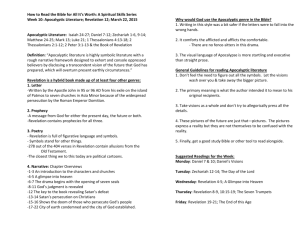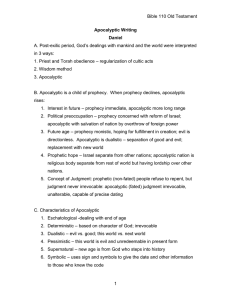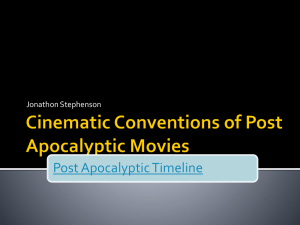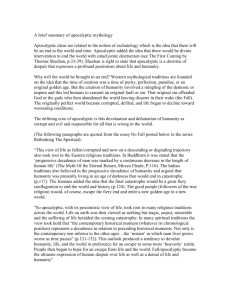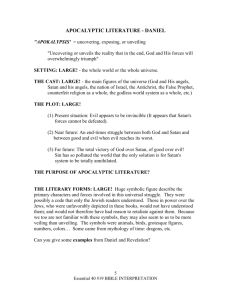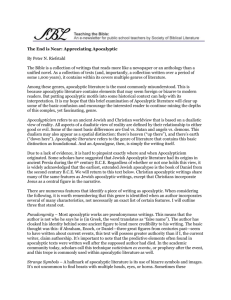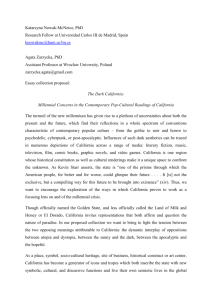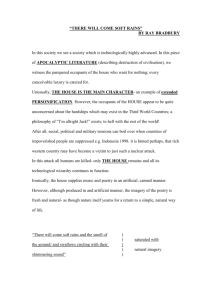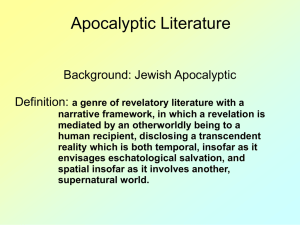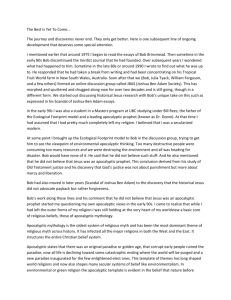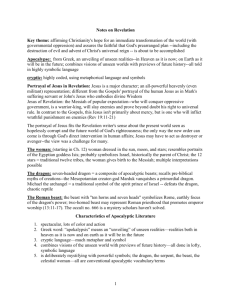THRS 393 Apocalypse Today
advertisement
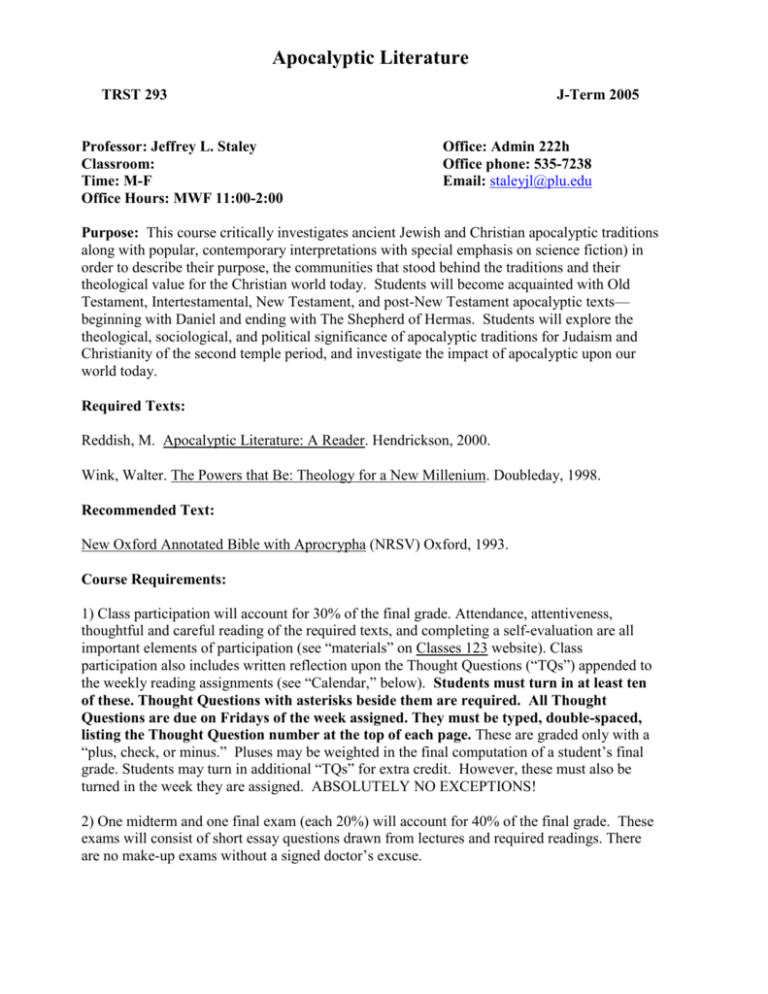
Apocalyptic Literature TRST 293 Professor: Jeffrey L. Staley Classroom: Time: M-F Office Hours: MWF 11:00-2:00 J-Term 2005 Office: Admin 222h Office phone: 535-7238 Email: staleyjl@plu.edu Purpose: This course critically investigates ancient Jewish and Christian apocalyptic traditions along with popular, contemporary interpretations with special emphasis on science fiction) in order to describe their purpose, the communities that stood behind the traditions and their theological value for the Christian world today. Students will become acquainted with Old Testament, Intertestamental, New Testament, and post-New Testament apocalyptic texts— beginning with Daniel and ending with The Shepherd of Hermas. Students will explore the theological, sociological, and political significance of apocalyptic traditions for Judaism and Christianity of the second temple period, and investigate the impact of apocalyptic upon our world today. Required Texts: Reddish, M. Apocalyptic Literature: A Reader. Hendrickson, 2000. Wink, Walter. The Powers that Be: Theology for a New Millenium. Doubleday, 1998. Recommended Text: New Oxford Annotated Bible with Aprocrypha (NRSV) Oxford, 1993. Course Requirements: 1) Class participation will account for 30% of the final grade. Attendance, attentiveness, thoughtful and careful reading of the required texts, and completing a self-evaluation are all important elements of participation (see “materials” on Classes 123 website). Class participation also includes written reflection upon the Thought Questions (“TQs”) appended to the weekly reading assignments (see “Calendar,” below). Students must turn in at least ten of these. Thought Questions with asterisks beside them are required. All Thought Questions are due on Fridays of the week assigned. They must be typed, double-spaced, listing the Thought Question number at the top of each page. These are graded only with a “plus, check, or minus.” Pluses may be weighted in the final computation of a student’s final grade. Students may turn in additional “TQs” for extra credit. However, these must also be turned in the week they are assigned. ABSOLUTELY NO EXCEPTIONS! 2) One midterm and one final exam (each 20%) will account for 40% of the final grade. These exams will consist of short essay questions drawn from lectures and required readings. There are no make-up exams without a signed doctor’s excuse. 3) One expository essay (see “Six Traits of Analytical Writing” under “Materials”) due February 27, analyzing a science fiction film from the perspective of ancient apocalyptic, OR a fifteen minute class presentation, due March 8-12, that analyzes a website in light of ancient apocalyptic. Either choice will account for 30% of the final grade. If you are writing a paper, it must be at least seven pages long (double-spaced, one inch margins, twelve-point Times New Roman font size). Bibliography is not counted as one of the seven pages. Your paper will be graded according to the “Six Traits of Analytical Writing.” “Ideas and Content” will count for 40% of the paper’s grade, “Organization” 20%, and the other four categories, 10% each. Highest quality papers will give evidence of having read and critically reflected on required readings. a) In no more that two pages, summarize the plot of the science fiction film you are evaluating. (See list below. Any other film not on this list must be approved by professor.) b) Taking the major themes of ancient apocalyptic literature, discuss these in light of your film, drawing from the readings in ancient apocalyptic for comparisons. c) Do you think science fiction is, in general, a modern-day equivalent of, or a development from ancient apocalyptic? Why or why not? d) Possible movies for analysis include the following: Terminator 1-3, Matrix 3, Twelve Monkeys, Planet of the Apes, Cocoon, Independence Day, Alien 1-4, Cocoon, 2001. 4) Your oral presentation will be graded according to the “Six Traits of Analytical Writing.” “Ideas and Content” will count for 40% of the presentation grade, “Organization” 20%, and the other four categories (modified for oral presentations), 10% each. Highest quality presentations will give evidence of having read and critically reflected on required readings, and will engage the class in productive, lively conversation. An additional five minutes will be given to questions from the class. Oral presentation of an apocalyptically oriented website must have the following components. a) A fifteen minute oral presentation of the website, plus five minutes for questions b) Students must turn in an outline of their oral presentation that includes bibliographic information and website name and address. Double-spaced, three pages maximum. c) Taking the major themes of ancient apocalyptic literature, discuss these in light of your website, drawing from the readings in ancient apocalyptic for comparisons. d) All websites being considered for evaluation must be approved by the professor. I am most interested in those that try to use modern science and technology to expand human potential (e.g., attempts at interplanetary travel, attempts to devise ways to live forever, theories of alien invasions, etc) e) Students must meet with me by February 13 to secure my approval for any prospective website being considered for analysis. Grading Scale 100-96 A 2 95-93 A92-90 B+ 89-87 B 86-84 B83-80 C+ 79-77 C 76-74 C73-70 D+ 69-67 D 66-64 D63Failing Midterm exam 200 pts Expository paper/ website analysis 300 pts Final exam 200 pts Class participation 300 pts _____________________________ Total 1000 points possible in the course Calendar January 5-9 Introductions: To each other, to the class, requirements, etc. How to find things in the Bible. An introduction to the Christian canon, and to ancient apocalyptic literature. Read Harper Collins Study Bible, pp. xvii-xxxix; Staley, “Choosing Between Twos: Apocalyptic Hermeneutics in Science Fiction, the Radical Right, and Recent Historical Jesus Scholarship” (on my webpage http://fac-staff.seattleu.edu/staleyj/ publications.html). **Thought Question 1: In two type-written pages, tell me about yourself. What or who has been the most important influence on your life? Why? What do you hope to become, and why? Attach a picture of yourself (photocopy of your Student ID card is fine). January 12-16 The book of Daniel (Susanna, Bel and the Dragon) Read Reddish, pp. 19-38; Wink, pp. 1-62 Read the Book of Daniel (Old Testament), Susanna, Bel and the Dragon (in the Apocrypha) **TQ 2: What does Wink mean by the terms “powers,” “domination system,” and “redemptive violence?” TQ 3: What evidence of a “domination system” do you find in Daniel 1-6? What evidence of the “myth of redemptive violence?” How are these counteracted in the stories of Daniel and his friends? January 21-23 The book of Enoch Read Genesis 3-6; Jude; Reddish, pp. 41-57, 143-162. 3 **TQ 4: What is the source of evil in the world according to Genesis 3? According to Enoch 1-10? How does evil affect the world in these two stories? TQ 5: Compare the “Animal Apocalypse” and the “Apocalypse of Weeks” from the book of Enoch. January 26-30 The book of Enoch and the Essenes Read Reddish, pp. 162-187; 224-240 TQ 6: Describe the functions of the Son of Man in the “Similitudes of Enoch,” and his probable identity. TQ 7: Having read most of the book of Enoch, what part did you like the best, and why? February 2-6 Jesus and Paul’s apocalyptic understanding of Jesus Read Matthew 10-11; Luke 10-12; 1 Thessalonians; 1 Corinthians 15; 2 Corinthians 11:16-12:10; Romans 1, 8 Read Wink, pp. 63-127 TQ 8: What does Wink mean by Jesus’s “Third Way? **TQ 9: Both 2 Corinthians 12:2 and 1 Thessalonians 4:17 use the words “caught up” (in Latin “rapture”) compare (who gets “raptured, what is the experience, when does it happen, and where does one go). **Exam on Monday, February 9** February 9-13 Paul and the “little apocalypse” Mark 13, Matthew 24-25; Luke 21; Pippin, pp. ix-31 TQ 10: Most scholars think Mark wrote before Matthew and Luke, and that Matthew and Luke used Mark as a source. Presuming this theory to be true, what are three significant changes that either Matthew or Luke make in their versions of Mark 13? **TQ 11: Tina Pippin claims that she lives in the midst of an apocalyptic culture. What does she mean by this? **Students doing oral presentations must meet with me by February 13 to secure my approval of website analysis. February 18-20 4 Ezra and 2 Baruch Read Reddish, pp. 58-142; Romans 5-6 TQ 12: Compare 4 Ezra’s and 2 Baruch’s views of Adam and sin. Which do you think is most similar to Paul’s view? Why? TQ 13: 4 Ezra 7:78-99 and 2 Baruch 49-51 are attempts to explain what happens after death. Summarize each, stating which of the two you find more satisfying, and why. February 23-27 The Book of Revelation Read Revelation 1-12; Wink, pp. 128-200; Pippin, pp. 32-42 4 TQ 14: Evaluate Revelation 6-12 in light of Wink’s concept of “the gift of the enemy.” **TQ 15: Compare the image of the beast in Revelation 13 with those of Daniel 7. **Science Fiction and Apocalyptic paper due February 27 March 1-5 The book of Revelation, the Shepherd of Hermas Read Revelation 13-22; Reddish, pp. 243-265; Pippin, pp. 64-99 TQ 16: Pippin wrote her chapter on “peering into the abyss” years before 9/11. Reflect on the post 9/11 “hole in the world” in light of Pippin’s chapter. TQ 17: Compare the image of the beast in The Shepherd with that of Revelation 13. What is the significance, do you think, of the beast having a head like pottery? March 8-12 Apocalyptic in contemporary American culture Read Pippin, pp. 100-127 **TQ 18: Evaluate an apocalyptic website of your own choosing using either Pippin’s discussion of apocalyptic fear or apocalyptic sex as a basis of critique. TQ 19: What apocalyptic images do you find most prevalent or most disturbing in contemporary American culture, and why? **Class presentations of apocalyptic websites March 15 Apocalyptic in contemporary American culture TQ 20: What is the most valuable thing you have learned in this course? Explain. March 18 **Final Exam 8:00-9:50 **Course evaluation, self-evaluation 5
